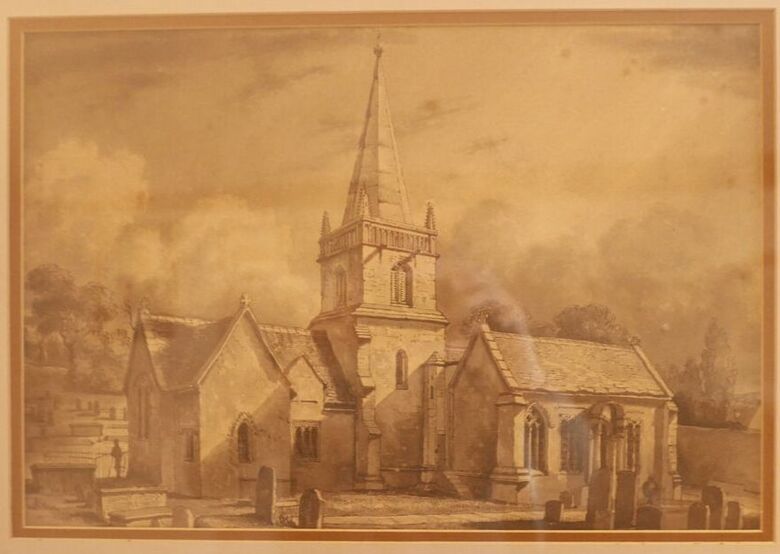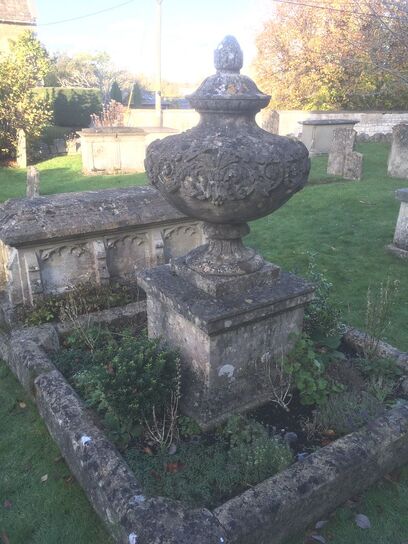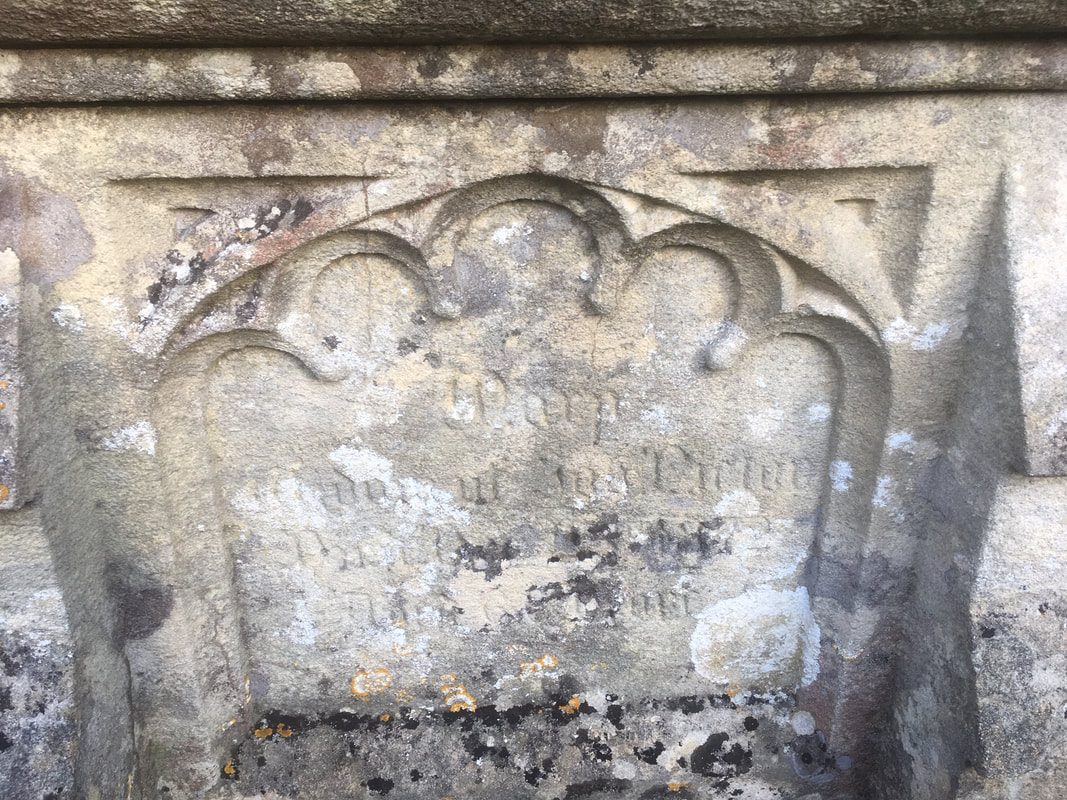Strong and Pictor Monuments Alan Payne June 2022
The tombstones immediately outside the north door weren’t positioned there by chance. In their time these people were considered important in the village and the location of their burial honoured their memory and the status of these families as the congregation shuffled in and out of the church. To secure these spots other bodies were disinterred and buried elsewhere.
Position of Monuments
The orientation of most churches is towards the east (even the word orient means east-facing). The high altar and clerical proceedings were towards the east and prayers were said in that direction in early Christian practice. Sometimes this end of the building was made even more important by an apse. It followed that the main entrance was on the west of the building. At Box, the west door with its elaborate Tudor arched window was formerly the main entrance of the church, directly accessed by the vicar from Box House. The north side of the church was rather a mess with a fourteenth century vestry and earlier Hazelbury Chapel seemingly tentatively connected to the main body of the church in the headline illustration of 1713.
The north door became the main entrance to Box Church in the late Georgian period. The north wall was rebuilt by Rev George Millard in 1713 when the Church Chambers above the north aisle were removed. The classical doorway entrance with columns was later still and has been dated 1760, possibly the 1713 alterations requiring further amendment.[1] It seems probable that the north door became the main entrance to the church for parishioners after that date. It followed that a burial in front of the north door was a very prestigious place, whereby residents could acknowledge their importance entering and leaving the church. For the residents of Box in the 1830s to 1860s, there were no people more significant than the Strong and Pictor families.
The orientation of most churches is towards the east (even the word orient means east-facing). The high altar and clerical proceedings were towards the east and prayers were said in that direction in early Christian practice. Sometimes this end of the building was made even more important by an apse. It followed that the main entrance was on the west of the building. At Box, the west door with its elaborate Tudor arched window was formerly the main entrance of the church, directly accessed by the vicar from Box House. The north side of the church was rather a mess with a fourteenth century vestry and earlier Hazelbury Chapel seemingly tentatively connected to the main body of the church in the headline illustration of 1713.
The north door became the main entrance to Box Church in the late Georgian period. The north wall was rebuilt by Rev George Millard in 1713 when the Church Chambers above the north aisle were removed. The classical doorway entrance with columns was later still and has been dated 1760, possibly the 1713 alterations requiring further amendment.[1] It seems probable that the north door became the main entrance to the church for parishioners after that date. It followed that a burial in front of the north door was a very prestigious place, whereby residents could acknowledge their importance entering and leaving the church. For the residents of Box in the 1830s to 1860s, there were no people more significant than the Strong and Pictor families.
|
Thomas Strong Immediately outside the north door of the church is a large monument erected to the Strong family. The monument is a listed building described as: Large ornate carved stone urn on pedestal with moulded base. Inscription to Thomas Strong of Fogleigh, died 1851. Thomas Strong was a master builder, born in 1781 who lived at Box Hill in 1841 with his wife Rowena, his son Robert and his brother and sister-in-law. Thomas leased a 2-acre plot of land (the site of a quarry) from at least 1832.[2] Thomas became extremely wealthy, building cottages on rough pieces of land between the new turnpike road and the old track.[3] By 1851 the extended Strong family had all moved to Fogleigh, where they were attended by two domestic servants. This ownership is reinforced by the Tithe Apportionment reference that Thomas Strong owned Fogleigh in 1840.[4] Thomas died there aged 72 in April 1851. This is presumed to be an early property on this site because the current Fogleigh House is dated 1881, designed by architect James Hicks of Redruth for the Pictor family. |
We can trace the subsequent Strong family. In 1856, Robert died leaving three infant children and by 1860 his widow, Eliza Ursula Strong, put the whole of the Wiltshire estate up for sale.[5] Possibly she was still suffering consequence from the bankruptcy that her husband had suffered in 1847.[6] Much of the land was cottages and building plots on Box Hill and, although not mentioned, it is likely that the Pictor family bought the Fogleigh area by private treaty at this time. The connection of the Strong family with Box continued after the Victorian period. Eliza Ursula moved to Reading with her two surviving children and but her death in 1900 recorded that she was the widow of Robert Strong of Fogleigh, Box. Robert and Eliza Ursula's daughter Eliza Rowena never married and left Box Church £300 for the maintenance of the fabric of Box Church in 1924, as recorded on a dedication board on the west wall of the nave.
For a brief time, the Strong family connection with quarrying also continued when another Robert Strong (1819-1887) - possibly cousin - took over the excavation rights in the area, calling himself a quarry master.
For a brief time, the Strong family connection with quarrying also continued when another Robert Strong (1819-1887) - possibly cousin - took over the excavation rights in the area, calling himself a quarry master.
|
Pictor Monument
There is another connection between the Strong and Pictor families because, immediately to the north of the Strong monument in the churchyard, is another stone mason’s tomb of the Pictor family. This is also a listed building, described by English Heritage as Chest tomb, mid-1800s, ashlar with 3 Gothic panels each side separated by buttresses, Gothic end panels, moulded base and ridged top stone over capstone. Inscriptions to members of the Pictor family, quarry owners, earliest decipherable date 1857. This date records the death of Job Pictor, the man who founded the Pictor dynasty and whose wife did much for the construction of Clift Quarry. |
When burials in the churchyard were stopped in 1858, these tombs were left as a snapshot of a period in time. It is coincidental that this period was the start of a significant development of the village, the beginning of an upsurge in the quarry industry, which led to the expansion of Box. The epitaphs remain as a historic tribute to that time.
Appendix: Grade II Listing of Strong and Pictor Monuments
Strong Monument
Strong monument in churchyard about 4m north of east side of north door of Church of St. Thomas.
Urn memorial, mid Cl9, ashlar. Large ornate carved stone urn on pedestal with moulded base. Inscription to Thomas Strong of Fogleigh, died 1851.
Pictor Monument
Pictor monument in churchyard about lm north of Strong monument, north of north door of Church.
Chest tomb, mid C19, ashlar with 3 Gothic panels each side separated by buttresses, Gothic end panels, moulded base and ridged top stone over capstone. Inscriptions to members of the Pictor family, quarry owners, earliest decipherable date 1857.
Strong Monument
Strong monument in churchyard about 4m north of east side of north door of Church of St. Thomas.
Urn memorial, mid Cl9, ashlar. Large ornate carved stone urn on pedestal with moulded base. Inscription to Thomas Strong of Fogleigh, died 1851.
Pictor Monument
Pictor monument in churchyard about lm north of Strong monument, north of north door of Church.
Chest tomb, mid C19, ashlar with 3 Gothic panels each side separated by buttresses, Gothic end panels, moulded base and ridged top stone over capstone. Inscriptions to members of the Pictor family, quarry owners, earliest decipherable date 1857.
Strong Family Tree
Siblings:
Thomas Strong (1781 - April 1851),
John Strong (1792 - 1850), a mason, and his wife Mary. It is possible that their child was Robert (b 1819 in Berkshire, d 1887) who took over the quarry company. By 1881 this Robert had married Mary A (b 1824) and they lived at Box Quarries where this Robert was called quarry master.
Thomas Strong (1781 - April 1851), master builder, married Rowena Rawlings on 5 April 1817 and they lived at Box Hill in 1841. In 1851 they lived at Fogleigh House with two domestic servants. Children include: Robert (11 January 1818 - 1856)
Robert (11 January 1818 - 1856) married Eliza Ursula Jackson (b 1821 Brighton, d 10 July 1900). Children: Eliza Rowena (1848-1923); Eleanor (b 1850, probably died young); Robert William Christopher (1852-1909).
Siblings:
Thomas Strong (1781 - April 1851),
John Strong (1792 - 1850), a mason, and his wife Mary. It is possible that their child was Robert (b 1819 in Berkshire, d 1887) who took over the quarry company. By 1881 this Robert had married Mary A (b 1824) and they lived at Box Quarries where this Robert was called quarry master.
Thomas Strong (1781 - April 1851), master builder, married Rowena Rawlings on 5 April 1817 and they lived at Box Hill in 1841. In 1851 they lived at Fogleigh House with two domestic servants. Children include: Robert (11 January 1818 - 1856)
Robert (11 January 1818 - 1856) married Eliza Ursula Jackson (b 1821 Brighton, d 10 July 1900). Children: Eliza Rowena (1848-1923); Eleanor (b 1850, probably died young); Robert William Christopher (1852-1909).
References
[1] See article Box Church
[2] The Bath Chronicle, 1 March 1832. The land was probably leased from the lord of the manor of Lullington, Somerset, near Frome, possibly William Duckworth.
[3] The Bath Chronicle, 1 March 1832
[4] Tithe Apportionment map reference 99
[5] The Bath Chronicle, 17 April 1856
[6] The Wiltshire Independent, 21 January 1847
[1] See article Box Church
[2] The Bath Chronicle, 1 March 1832. The land was probably leased from the lord of the manor of Lullington, Somerset, near Frome, possibly William Duckworth.
[3] The Bath Chronicle, 1 March 1832
[4] Tithe Apportionment map reference 99
[5] The Bath Chronicle, 17 April 1856
[6] The Wiltshire Independent, 21 January 1847


